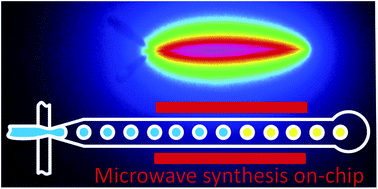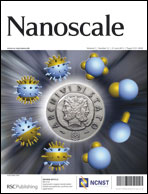Microwave dielectric heating of non-aqueous droplets in a microfluidic device for nanoparticle synthesis†
Abstract
We describe a microfluidic device with an integrated microwave heater specifically designed to dielectrically heat non-aqueous droplets using time-varying electrical fields with the frequency range between 700 and 900 MHz. The precise control of frequency, power, temperature and duration of the applied field opens up new vistas for experiments not attainable by conventional microwave heating. We use a non-contact temperature measurement system based on fluorescence to directly determine the temperature inside a single droplet. The maximum temperature achieved of the droplets is 50 °C in 15 ms which represents an increase of about 25 °C above the base temperature of the continuous phase. In addition we use an infrared camera to monitor the thermal characteristics of the device allowing us to ensure that heating is exclusively due to the dielectric heating and not due to other effects like non-dielectric losses due to


 Please wait while we load your content...
Please wait while we load your content...